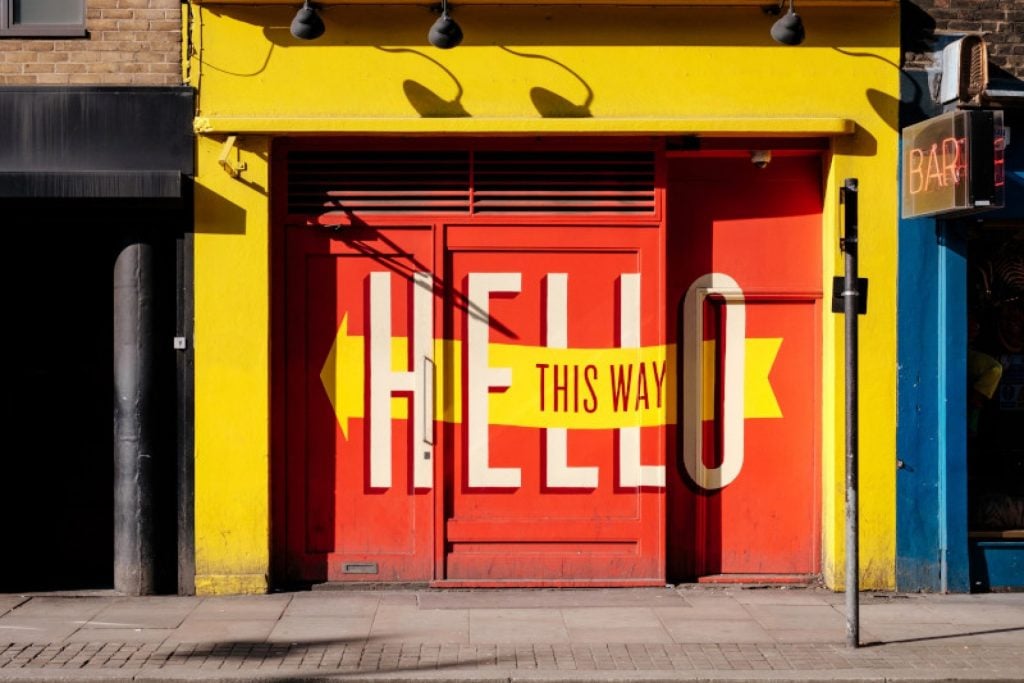Read this guide to learn more about how successful retailers and hospitality businesses have mastered the art of implementing great display product strategies and how you can apply this to your business, too!
Majisign works with many leading companies in the food & beverage, hospitality and retail industries to make bespoke and customised wooden display products, as well as fulfilling print requirements for posters & banners and general large format signage. We’ve curated some excellent advertising ideas that can help you increase the positive perception of your business and help with your next advertising campaign.
What display products are
Visiting a shop, wandering down any high-street or relaxing at your favourite spa; display products are everywhere. Sometimes they are large “cannot miss it” displays as well as small, more subtle objects. They all act as design or emotional cues to help promote customer actions – from feelings of wellbeing to being at ease (more on this later) and of course to promote the need to buy a product or service. There’s a large range of products available – we discuss which ones you and your customers will love as well as some buying advice and things to look out for.
Before we continue, we’d like to welcome you to Majisign! You can read a summary about what we do here – and we do it with lots of pride and expertise.
Posters and banners
The most basic display products are posters and banners. They’re an effective medium to say whatever it is you need to, with minimal investment.
Posters are typically framed with poster frames, traditional interior frames or snap-frames (and if you’re not doing this and using blu-tack, staples or drawing pins – stop!) and strategically placed to catch the eye. Banners are for larger-scale announcements and when our audience is at a distance. Commonly they’re used on perimeter fences and readable from a road or draped across a structure; for example, across fronts of pubs and restaurants.
Majisign makes some beautiful wooden poster frames. They’re hinged and great for displaying menu displays and promotions. They also sell metal “slimlocks” and other variations.
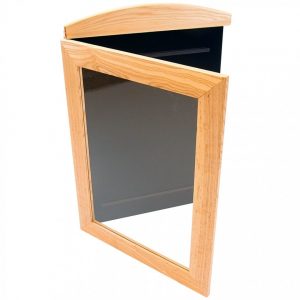
It’s recommended to have all of your posters and banners printed onto vinyl. Read our article about waterproof pvc posters here. Vinyl is a great material to print on since you’ll have a durable product and it’s weatherproof. UV-stable inks can be used, giving you a print quality that’s not going to fade over time.
Next, we move into more tangible products. Here we find pavement displays and poster frames for outside, whilst menu/list/promotional holders can be found inside. We’ll start with the larger products and progress to the small stuff.
Pavement signs & presence
A-boards, A-frames, swinging metal signs and those huge ones on springs; mastering the art of pavement display is a must for all businesses. For some, it is more appropriate to consider general signage – for example, fine dining restaurants prefer to present a name plaque adjacent to the main entrance and utilise potted plants, rails and carpets as their “pavement display”. For other businesses, having a sign physically stood on the pavement is most desirable. Pubs, bars and cafes will often opt for some perpendicular pavement presence!
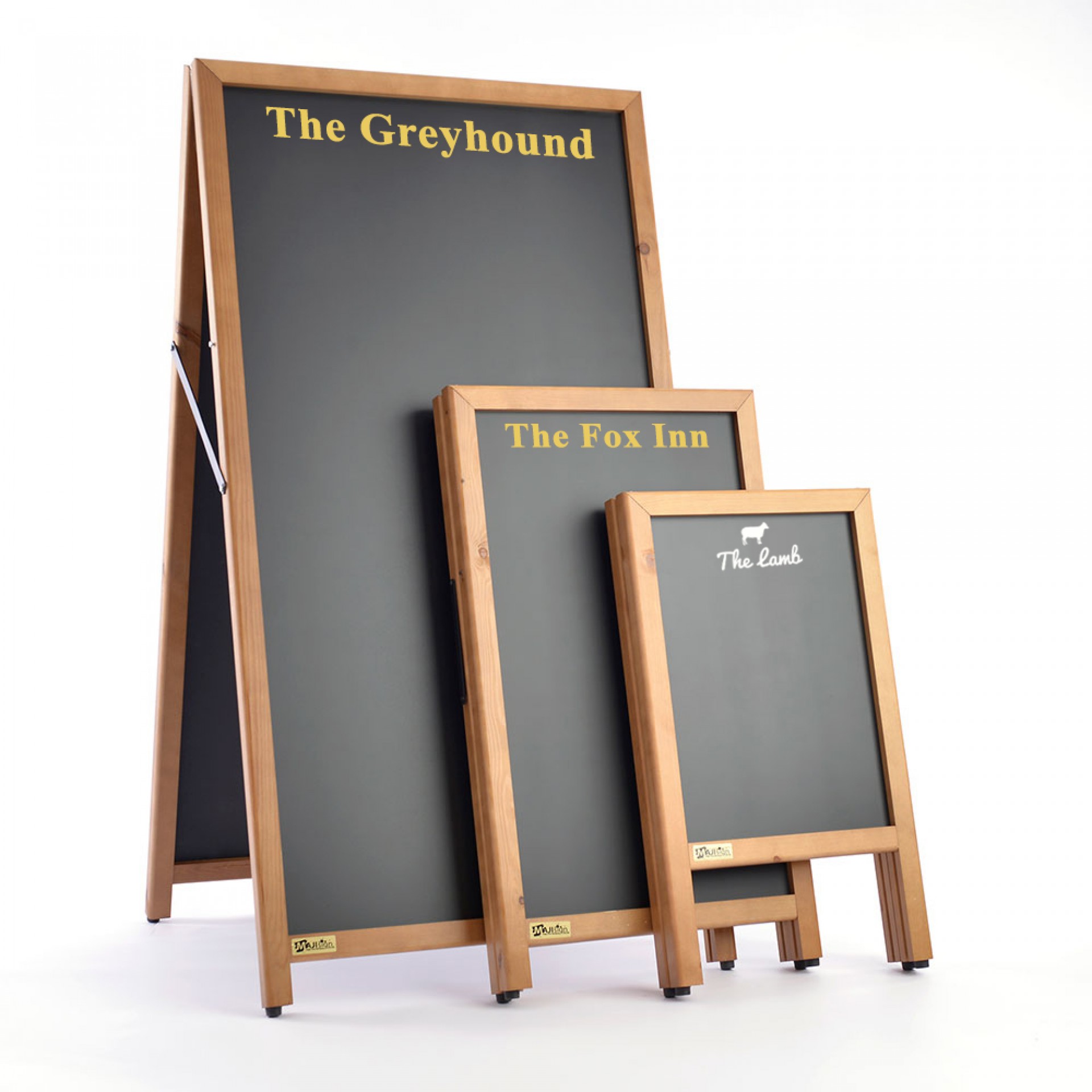
Above: The traditional a-board is sometimes called a sandwich board, forecourt sign or sign board. Its universal appeal means it’s attracted various names over the years.
A-Boards are fantastic at showing passing customers your latest ad campaign and can produce better conversions than any electronic means such as facebook ads, social media campaigns or any online advertising. The high street promotion should never be overlooked, especially on price. For a modest investment, you can make a compelling promotion that is bound to increase visitors.
There are many types of A-Board and they are an accumulation of much of the information in this article, rolled into one product! This is especially important to appreciate so you can pick the right kind of sign. Wooden A-Boards have an advantage over other pavement signs since they tend to be less bulky than metal and plastic equivalents. The reason is that A-Boards are inherently heavy, which means that a bulky base is not required. This also means that you aren’t placing a trip hazard into the street!
The very best A-Boards will be well protected from the weather and fine for exterior use. Generally, they will hinge at the top and display their faces at an angle. A metal stay is used to maintain the angle of the board. Look for products that feature rubber feet, since this will enhance the sign’s ability to resist standing water.
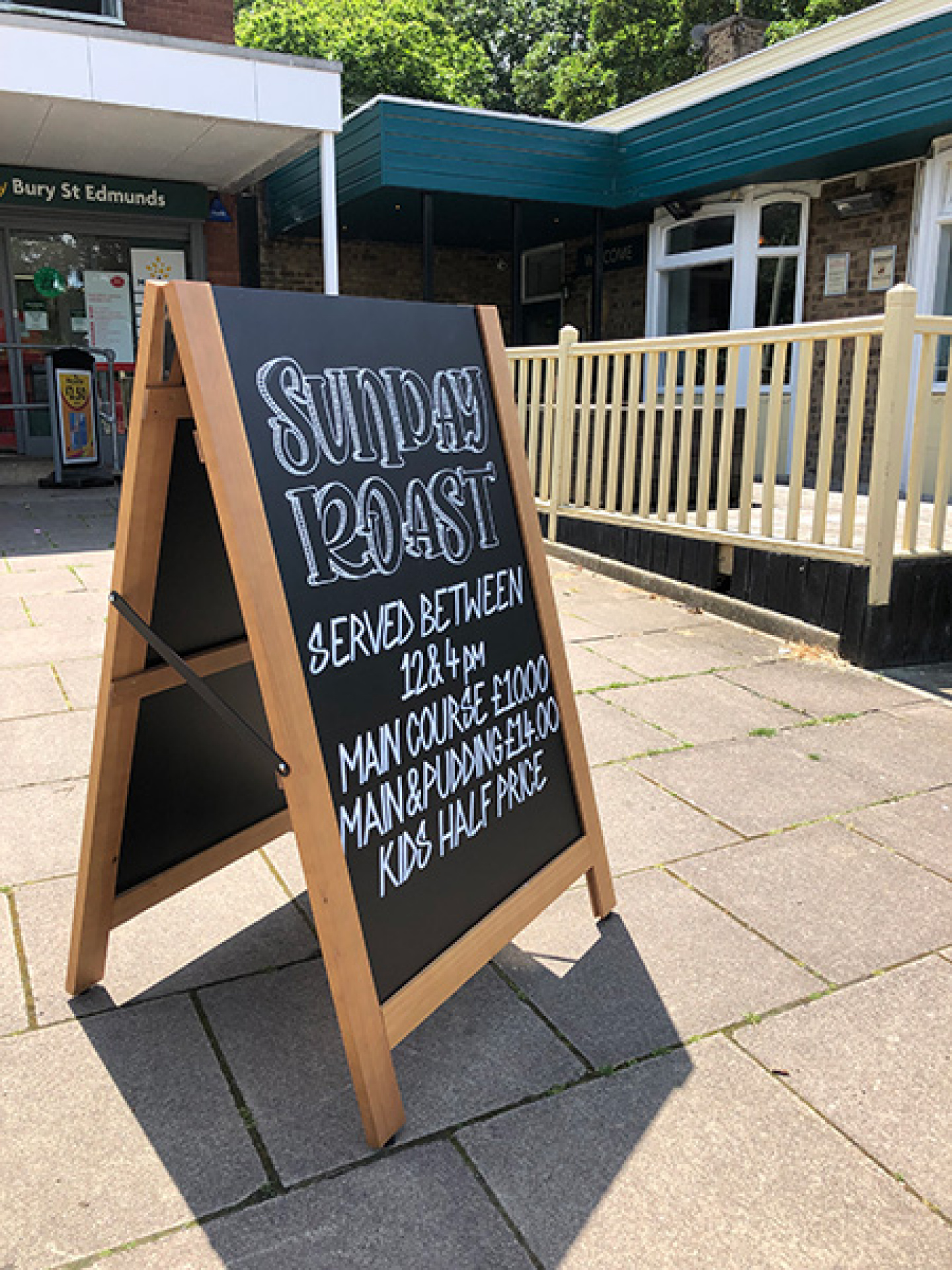
Above, Majisign’s a-boards feature rubber feet.
Aesthetics aside, it’s important to make the right decision about the board type. There is chalkboard, printed and snap-frame options for the face and some feature a header. A header simply means a useful place to display your business name, logo or brand separate from the message that you want to tell people. There’s often a small extension at the top of the board and can follow the form of the board or be shaped into domes or custom shapes.
The chalkboard is just that- a blackboard that can be written upon. Snap-frames can be mounted to the face of the board and are sleek ways to display posters. This can be very useful if you need to change your content often. Simply swap posters as you need.
The printed board option shares the convenience of the snap frame, if you choose a reversible option. The boards are often fixed into place, which means they cannot be changed. If you need to change the board (which let’s be honest, is likely) choose a reversible option. The board itself should be manufactured from foamex or correx.
Foamex is lightweight and solid, with a smooth face. Correx is much like cardboard but in plastic form. It is often cheaper than foamex but can suffer from a “wavey” face. Nevertheless, each board can be removed easily, by sliding it out of the frame. Double-sided printed boards are often used since the board can be reversed and slid back into the frame – hence reversible. Consider this option if you want to change your advertising often or you simply prefer the ability to change later.
Below, from left to right: An A-Board with fixed chalkboard board, with snap frames, with printed foamex inserts
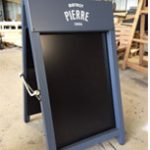
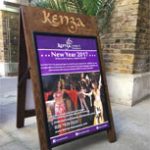
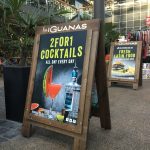
There are also speciality A-Boards which are more complex in design to the traditional A-Board. For example, Majisign makes a beautiful “stash A-Board” which is slender in nature and features a storage area at the base. It is also easily folded up.
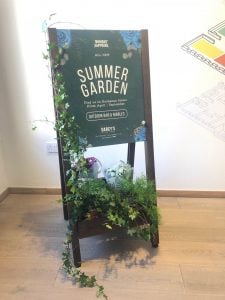
Their Skyward A-Board is much like a piece of furniture with its solid oak legs. It’s very elegant indeed.
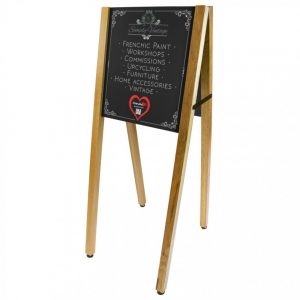
Nearly all wooden A-Boards will be manufactured in softwood. This is most likely pine, finished in exterior stains and varnishes. Ensure that the supplier knows what type of wood and finishes are used and that the timber has been responsibly sourced. You’ll know this since you’ll see the term “FSC” used. Metal hardware needs to be quality chrome or brass.
Chalkboards
The most universally loved product is the chalkboard! It’s so diverse that you’ll see them attached to outside walls and on the interiors of any hospitality businesses. They can be presented behind bars- large ones acting as an entire backdrop, whilst smaller ones can be framed and fixed to walls. The last and most intimate option is to use a small (A4 and smaller) chalkboard that is mounted to a small wooden block base or mounted to a small easel.
Chalkboards are fantastic since they’re easy to adjust at a moment’s notice. There are 3 options for communicating on chalkboards;
Firstly, traditional chalk can look great, especially if a few colours are used. This requires some artistic flair to look brilliant, especially as chalk can be tricky to work with.
Second, the liquid chalk pen is a great invention as writing and drawing are more natural to most since a felt nib is instantly more controllable. The liquid ink dries and is generally more hardwearing than chalk. However, some cheaper chalkboard surfaces will absorb this ink even after it has been cleaned. This becomes an annoyance since this shadow (or ghost) persists, even when a new message has been written. Owners find themselves needing to repaint the surface often. Majisign’s chalkboard surface is ghost & shadow resistant.
The third option is to use digital print. Printing directly to the chalkboard is always worth considering. Your business name or logo can be printed into a corner or be part of the title- leaving space to draw and write with a liquid chalk pen. This hybrid can look fantastic. Or the entire chalkboard can be printed. This is especially useful if a lot of information needs to be presented on one board, often in a smaller (and thinner) font than one can write with chalk. Wine lists and craft ale menus work well here, especially when the drink’s name, brewer, ABV and price needs to be shown. Majisign can print with white ink, so it’s possible to still achieve a high-contrast look.
Below, a simple mini chalkboard, handwritten. Chalkboards don’t have to be huge!
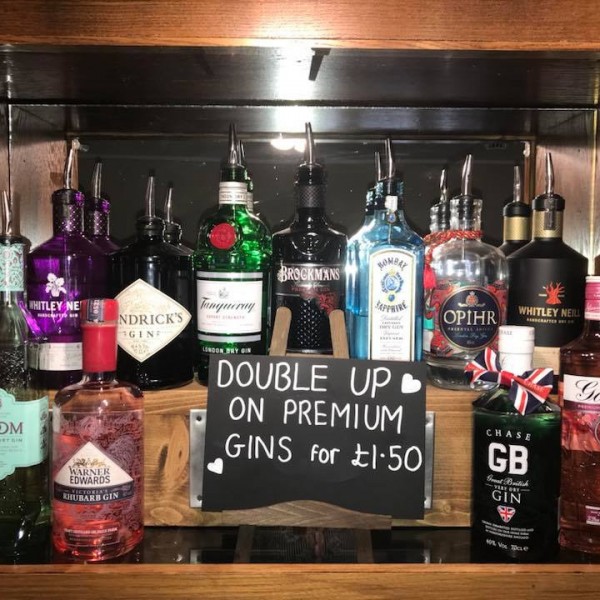
Larger chalkboards can make a large impact, either wall-mounted behind the bar or on an easel, especially when in larger A1 or A2 sizes.
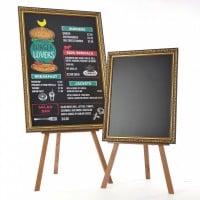
The slatted board demonstrates how a chalkboard look can be achieved with white, digitally printed text. There’s a lot of information displayed here, which is why the digital print works fantastically well.
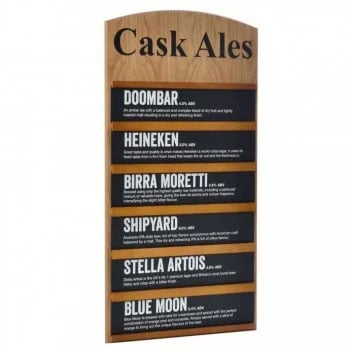
Products for table & countertops
Table/bar/desktop products are the smallest but potentially the most powerful. These are products that hold flyers, menus, sachets of sauces, sample, cutlery and other promotions. They’re powerful since they’ll be communicating up close to your customers.
Below, a wooden table talker advertising a social media profile
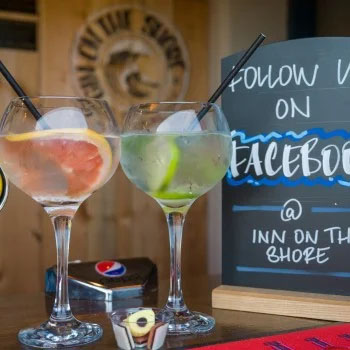
This is where attention to how the product is finished & printed is important. Touch also needs to be considered, if your customer is likely to pick the product up. A simple example here – restaurants that use wooden spoons to display table numbers. Presenting a rough & greyed spoon isn’t ideal. Writing the number on in permanent marker is also a bit cheap, especially when the ink bleeds into the wood! Providing a highly sanded, smooth (even hardwood version) spoon promotes quality and attention to detail. A printed number or having inset on a metal disc can look great as well.
We’re not saying use wooden spoons; rather you must draw synergies with the product you are selling and the overall impression that you’d like your customers to have.
The same applies to menu holders; the holder itself needs to be of a standard that meets the level of food and service. A menu holder can make for a lovely presentation on the table, whilst small table talkers are often better suited to bars and countertops.
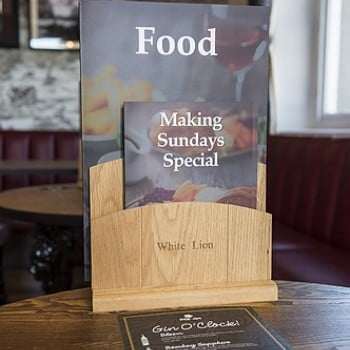
Ensure that your smaller products (and thus, smaller print) remain on tables, whilst slightly bigger products such as table talkers (and their often much bigger print or chalk writing) stay at length in the bar or window display.
Easels & stands
Easels are incredibly useful since they give you an instant foundation; even if it’s right in the middle of a walkway. Taller easels can make a lovely welcoming ambience, especially when presented sympathetically to the existing interior décor.
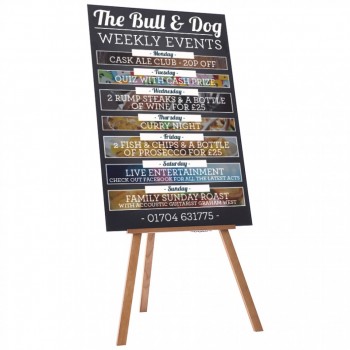
Showcasing products is less of a challenge since when presented on an easel, makes an obvious focal point. A chalkboard is a popular choice, although there’s nothing to stop you choosing a fully-printed board.
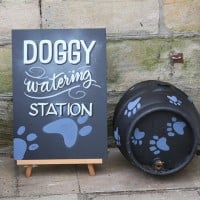
Above, easels & chalkboards aren’t just for humans…
Condiment holders and caddies & laser engraving
Whilst not strictly display products, it is still worth noting how condiment holders, caddies, boxes and crates can benefit from a little bit of personalisation. Wood engraving looks beautiful. Choose laser engraving over the “hot stamp burnt look” for ultimate refinement. Here’s an engraved condiment caddy for The Fox;
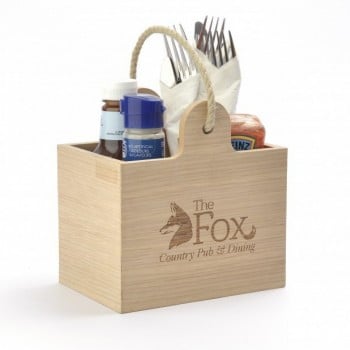
Everything else….
From parking signs, door titles and labels for portraits to larger business name signs on top of warehouses and other speciality graphic displays. Always look for UV inks and choose dibond or dilite signage for great durability.
Best locations for display products
We know that first impressions count and that we need to keep our customers returning, time after time. It’s important to keep them updated whilst they’re visiting. This is also a great opportunity to sell additional services and products.
Start by identifying 2 types of areas within your premises:
- Areas of high traffic
- Areas of high dwell time
Each area needs its own kind of display product. High traffic areas are physical spaces where lots of customers pass a particular point. It’s now time to assess if those passing feet are fast or slow. If fast, promotions need to take only a moment for people to read and there can’t be any reason for people to stop to read, especially if other customers are trying to make their way past that point, too. If your high traffic area can afford it, make more of a presentation that gives your customer the opportunity to digest the promotion without stopping, or be daring and offer the chance to grab a flyer or booklet.
Areas of high dwell time are going to be places where your customers spend more time. In these areas, you can be more adventurous and verbose with your promotions. Remember that context is important, so offering related promotions is key. Promotions of higher value tend to convert more readily in areas of high dwell time
On the left; a promotion for high-dwell area whilst on the right, a promo for high-traffic areas
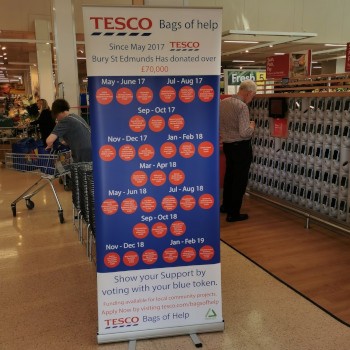
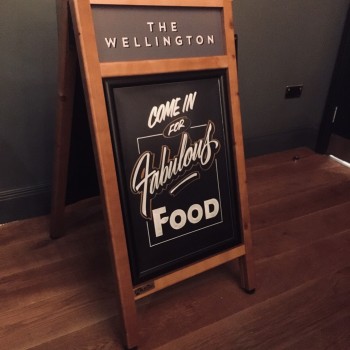
Some examples of how different in a bar, restaurant or pub, may be categorised:
Bar countertop – High traffic, variable dwell. What works? Drinks offers, meal coupons, guest ales, etc. “above bar” offers that can be seen from a distance when the bar is busy and people are queuing
Corridors & interconnecting routes – High traffic, low dwell. What works? Posters (in frames or snap frames) with easy to read, obvious deals
Entrance hall – High traffic, variable dwell. What works? Use your judgement to promote your flagship service or product. It’s a matter of balancing traffic and dwell
Smoking & vaping area – Variable traffic, high dwell. What works? Related product & drinks offers, more expensive offers, potentially for repeat visits (e.g. longer stays, restaurant bookings)
Banner promotions work best for single “business-wide” promotional offers or updates. Including too much detail on a banner can reduce the sign’s readability from a distance. Think “Sunday Roast for £7.95”, “Reopening Soon” or using a series of icons for services or products offered.
Poster displays are more intimate in nature, so they either need to be very simple in their messaging, since they are often placed in high-traffic areas or if they have detail, they need to be in places of longer dwell time. This is precisely why informational posters are displayed in bathrooms and “Buy 1 get one free” offers are advertised in corridors.
Welcoming products such as lecterns, pop-up banners, exterior poster frames and easels are brilliant at introducing dwell time. When customers see these, they instantly focus on them as they are also great waypoint markers. Here is a fantastic opportunity to introduce related services and products or simply reconfirm their choice. It is important not to alter their goal.
If a couple are visiting the restaurant for a meal and they spot your welcoming lectern, don’t offer any food or drink offers at this point. The expectation of any restaurant-goer is to be welcomed and shown to their table. Introducing offers at this point can slow this moment down and even make it awkward, especially if the offer becomes a talking point. Instead, leave these types of offers for the table and use either a table talker or menu holder to promote.
So at welcoming points, display information about that service or product since this acts as a powerful confirmation that their decision is correct.
A-Boards have become traditional due to their runaway success! Just like those welcoming products above, the A-Board confirms arrival, which is a vital cue to our internal navigation. The feeling of arrival should be one of excitement, which is why the A-Board is vital to promoting your most important services and products. A headed A-Board is useful since it clearly displays your business name across the top. Depending on your preference you can either:
- Use a chalkboard and have some chalk art drawn
- Opt for a fully-printed sign with great graphics
- Use printed posters inside snap frames
Remember, whatever you choose, the A-Board must say “you are at your destination – look at these great things you need!”
Chalkboards are the designer’s dream. They look great wherever they’re placed. The trick with chalkboards is to buy high-quality and if framed, keep those looking clean and tidy. Consider using chalkboards for ad-hoc promotions. The handwritten nature of a chalkboard conveys feelings of trust but also an urgency- as if the bar manager had quickly decided to make the offer available just for the individual that’s reading it. A combination of white print (for example a brand or name) can look fantastic paired with chalkboard art. Framed chalkboards are viable options in place of framed posters.
Below, a chalkboard paired with an easel. This makes an ideal prompt for your customers to stop and read.
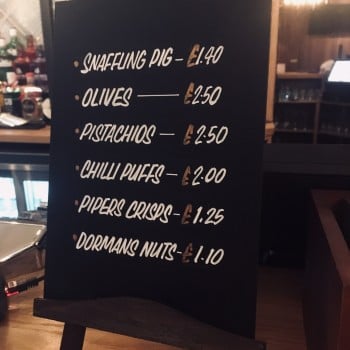
The most private of moments for your customers will be when sat at a table with family and friends. This intimate gathering means that your entrance presentation and bar offers are probably long forgotten! Table talkers & menu holders ensure that you have a presence, right on the tabletop. Depending on if you’re serving food, drinks or the table is just a side item to a waiting room, you’ll be wanting to continue the themes of your promotions right up close with your customers.
Below: Menu holders are a brilliant way to get your message up close and personal with your customers
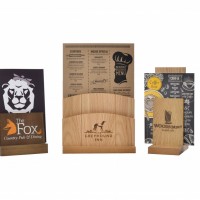
Table talkers are available in various sizes however we recommend small A5 or A6 for tabletops. Use them to promote your at-table services. It’s the perfect moment for upselling – which simply means advertising an offer of a slightly more expensive product or “value offer”, combining various products and services together into one deal. Menu holders are the perfect opportunity to present your menus. Tiered menu holders are ideal for separating out different lists; from food & drink to massage & face treatments. You can also separate out your information into standard items and then have promotional offers separate. Below is an example of how a clip is used with a paper or laminate.
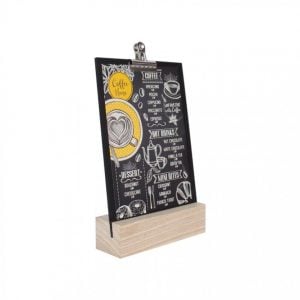
Let’s recap on display product positioning:
- Use easels, popups and lecterns to increase dwell time
- Place smaller holders on tabletops
- Keep your messages short when placed in high-traffic areas
- Identify where customers spend time and augment this with more information and package deals
- Consider the effect on handwriting and use chalkboards where needed
- Be in on every conversation with table talkers and menu holders
- Always confirm that every customer decision is the best decision; use confirmation signage to reassure.
- Start with the entrance to your business and work your way in. There’s no point starting on the inside when nobody is visiting
Kerbside appeal
Watch any property program and they’ll tell you that kerbside appeal is incredibly important when selling a residential house. For businesses, every day is a selling day! The perception of your business from the outside is paramount to success. Regardless of the value of what you are selling, every business should be clean, tidy, smart and most importantly, approachable.
Any signage, A-Board or pavement sign is going to tell customers what to expect inside. And buying all of this promotional signage can add up to a significant value. Regardless of the exact products you choose, ensure that whatever money you are investing is made so in high-quality products
Checklist for buying wooden a-boards
- Any wooden product should be finished in exterior paints, varnishes and stains and the hardware should be high-quality chrome or brass
- If using metal signage, ensure it is made from aluminium. This avoids rusting.
- Use vinyl posters, even indoors. Any amount of airborne moisture can cause wilting and ink runs.
- Any digital print needs to be using UV-stable inks. This means they will not fade when exposed to sunlight
- Ideally, work with a manufacturer that includes a free design service (such as Majisign; https://www.majisign.co.uk) so that your designs can become a reality. Avoiding expensive design costs is certainly welcome.
- Where possible use a company that can brand your items for you. Reasserting your brand through printing directly to wood creates a much better impression over generic imported items.
Brand enforcement & building affinity
When customers choose to visit you, you should ensure that constantly reconfirm that their choice was correct. You can do this by branding items;
- Using your business name on posters and print
- Wood engraving on menu holders and covers, condiment caddies and table talkers
- Digital print on chalkboards
This gives you the ability to complement existing brands that you may want to promote, especially if you are a partner or a certified supplier. The point of doing this can be demonstrated in the pub trade- local pubs will often sell the same lager but customers will always have a preference of venue. By asserting their pub name, it creates affinity with your business as well as strengthening their belief in the brands that you serve or sell.
Have you ever watched a TV advert that appears to be advertising anything but the product? This notion is called random affinity and is really useful for products that don’t immediately evoke emotion or have any semantic relationship with the contents of the advert. By finding common ground between the advert and potential customers, a synergy can be created. An advert for life insurance could be really dull, however, if the signage uses images of families sharing an experience (let’s pretend it’s a picnic) and the focal point is on children innocently playing, the insurance product quickly gains attractiveness through sentiment and equally plays on the minds of those customers that feel a strong affinity to support their families and even generations yet to arrive.
According to HBR:
People who report an emotional connection to your brand will be twice as valuable as even your most “highly satisfied” customers.
Promotions should have the following qualities
- Build affinity through evocative imagery
- Shout about your name, brand or product
- Ideally, feature an image of the product – if intangible it must be present in the text
Aside from the specific emotions and sentiment, you need to convey, above all always appear authentic and genuine. This mostly pertains to your text; be especially careful with exaggerations or novelties that can be misinterpreted.
Material choices & how they make us feel
The ambience of hospitality generally calls for the natural hues and finishes only found in wood, whilst any service or product remotely medicinal (from nail bars to make-up sales) generally benefits from acrylics and other plastics. Largely, the choice has been made for use through current trends. Since our awareness of how plastic is managed has come to the forefront of most buying decisions, wood products are ever-increasing in popularity. Our recommendation is that even if your usage would naturally call for plastic products, there are going to be wooden alternatives available – and it’s all about the finish to convey the feelings you’re after. Sharp, clean lines can be achieved in wood, after all. The wood is probably going to be best coated in a complementing colour such as black, silver or white.
It’s particularly hard to measure this intangible aspect of how a material may evoke an emotion. An easier concept is the user experience that the material provides. For example, whilst an acrylic menu holder may be cheap and easy to use for the business owner, it may appear to be too cheap with its sharp lines and may be covered in smears or fingerprints from other people. It’s this subtlety that should be considered. A wooden alternative is more natural and tactile, which may be more important.
Here are some examples of how materials are used by designers vs. plastic
- Carbon fibre is used for emphasis on speed and mechanical performance
- Drinks served in glass bottles always tastes better
- Velvet for fitted cases & jewellery boxes emphasis sumptuous luxury
- Leather for baggage and accessories is personal, handmade and crafted
For points of sale and general display, wood is a universal medium since it can be finished in different ways;
- Completely plain for sanitary and food use
- Highly polished for luxury
- Painted for any other look or branding
- Engraved or printed for the crafted feeling
Emotion and feeling aside, there are practical requirements that usually favour wood for display equipment. It’s generally safe; it doesn’t break into a hazard, it usually won’t be abrasive and for the most part, it is light. Wooden items can be easily cleaned if finished appropriately, too. Stained or painted wood is ideal for exteriors. Modern finishes can be incredibly hardwearing. Wood is also reasonably easy to repaint without the issues surrounding painting on plastics. It’s this kind of advantage that means if you need to change or maintain the finish, it can be a do-it-yourself task.
Commercially, the cost of wooden display items is much cheaper than high-quality metal or plastic equivalents. Ultimately wood is the material of choice.
Digitally printed fonts or handcrafted text?
It’s purely a matter of building an attachment to your product or service! There’s a concept called “activation theory” and it is this that plays a very important role in how your wish customers to behave. We all require stimulation prior to action. This could be based on variation, complexity, uncertainty or novelty. Without stimulation, we get bored and tend not to create any action whatsoever. Making your products and services appear more human, this humanisation can yield positive attachment from your customers. If you can blend your promotions with humanisation, your customers will start building trust – and to do so they need an incentive through activation. Just like we build trust with other humans, it’s important that they do this with your business, too.
Below, a handwritten table talker inviting you to play some pub games. A subtle cue!
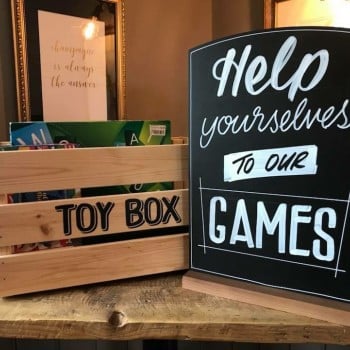
Think of your favourite brand. What comes to mind? Is it the face of the CEO, happy workers or the social effects the products can have? Is there an effective loyalty program or is it just the simple matter of interacting with a real person than a robot? How does that brand tell you that it can be trusted and is sincere?
Making steps towards humanising your brand is the first step to creating loyalty and a great community of customers. How can you start achieving this with wooden display products and signage?
Handwriting is sincere since it is human-produced. Having a thought pass through another’s brain and have it written out to us is very comforting and persuasive. Flyer advertising often tries to communicate this point, often quite badly- most flyers will feature a drawn oval around the most important information or another icon such as a tick. The problem here is that often they just look plain bad! The sentiment is there but the execution lacks context. However, on non-paper formats, such as chalkboards and table talkers, you absolutely should draw attention to special parts of your messages with icons, underlines and colours. We know that contrast is important. So much like we may write in dark ink on light backgrounds, you can do the same with handwriting by combining it with printed fonts.
Below; using differing typefaces to create contrast
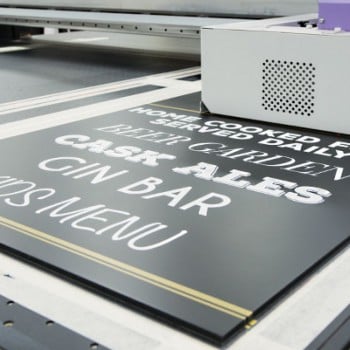
Strategies for switching and changing promotional ideas quickly
The theories about promotion particulars or great to know but you must also assess the practicalities of implementing the promotions and your brand or business. Changeable signage that uses chalkboards are straightforward to rewrite, however, digitally printed boards and signs are a harder proposition to change…. unless you buy the right product.
Depending upon your type of business, the need to change promotional messages will differ. From advertising breakfast in the morning to evening meals at night, hospitality generally finds that it is beneficial to advertise all sorts of offers throughout a working day. Other businesses may be far more sedentary. Even if your need to change is fairly infrequent, you should still consider some changeable products if for no other reason that to save reinvestment costs later.
Let’s take the pavement A-Board from earlier as an example. The A-Board displays the pub’s name across the top and then has 2 offers (one on each side) digitally printed. Rather than opting for the monetary “happy hour (2 cocktails for £12) on one side”, this business is luring and tempting their customers with “fabulous food”.
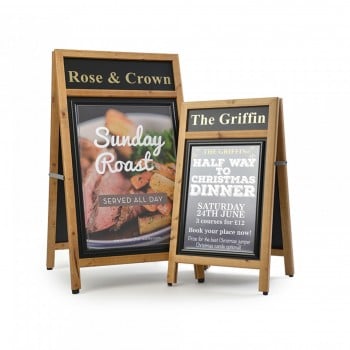
Clearly, the sign’s presence means that is advertising the business (and the 2 offers) and it looks fantastic. But it is static. If you look carefully, you’ll be able to see a snap frame.
Without a snap-frame, it is going to be almost impossible to add further promotions to it or change the price of those cocktails later. It may be possible to affix a vinyl sticker later to amend the details but it could detract from the impression you’re seeking to create. A chalkboard could work but may not be able to include all of the detail or specific font you’re after. You want a precise, colourful printed display. What options are there for changeable signage? There are products that can help and we’d suggest you consider:
- The snap-frame A-Board
- Reversible insert A-Boards
The snap-frame A-Board is available in different guises however all share the idea that a snap-frame is fixed to the board’s face, as above. The snap-frame is a metal poster holder and the poster can be easily changed by opening the surrounding frame. We highly recommend using posters that are printed on vinyl and the UV stable inks. This is critical if the A-Board is going to be outside.
The reversible A-Board is a slightly different proposition to the snap-frame A-Board. Instead, the entire board face isn’t fixed germanely in-place. Rather, the board is made from foamex (a lightweight sheet material) and slides in and out of the A-Board in engineered grooves. This brilliant feature means the boards are really easy to change but also can be double-sided! The board can be lifted out, reversed, then inserted. Designing and using new boards is always possible.
Below, a reversible A-Board and infographic:
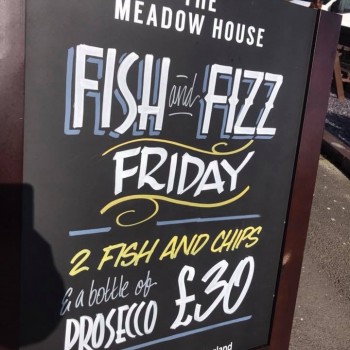
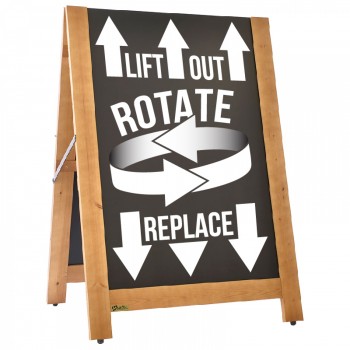
And a close-up of a printed foamex and correx boards. Remember that foamex is preferred due to its smoother face and more rigid properties:
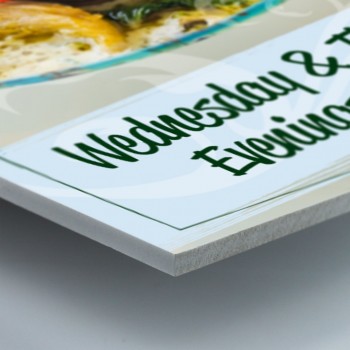
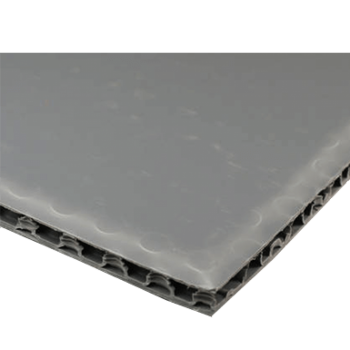
Conclusion
To conclude this article, we should briefly recap the most important points:
- Considering using wood over aluminium or plastic. Its form is sharper, more practical and sustainable
- Place large display products outside and smaller ones inside (with the exception being welcoming areas that use lecterns and easels)
- Evaluate how you present information on the table or countertop so that customers are always kept informed
- Promote greater value in high-dwell areas and keep your messages short in high-traffic ones
- Try to have your display products branded to promote authenticity
- Evoke emotion through colour, imagery and font selection (including handwriting!)
- Consider how best to change your offers and promotions according to customer needs, using snap-frames and removable printed inserts
- Find a display product manufacturer that is able to design your promotions with you
- Consider working with Majisign and they have a free design service and can make bespoke products
This article first appeared at https://www.majisign.co.uk/article/the-ultimate-guide-to-promotions-marketing-with-display-products on 23rd July, 2019
